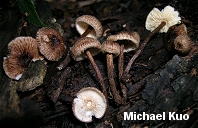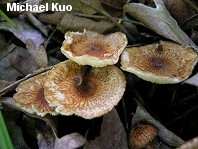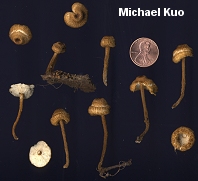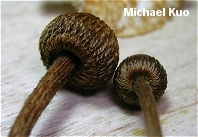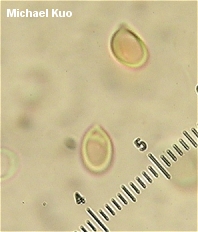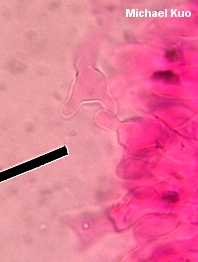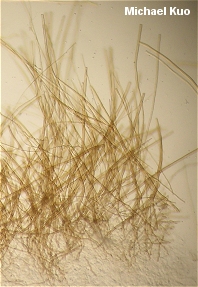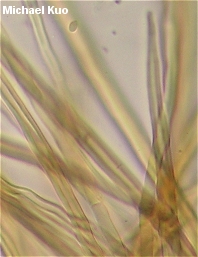| Major Groups > Gilled Mushrooms > Pale-Spored > Collybioid > Crinipellis zonata |

|
Crinipellis zonata [ Basidiomycetes > Agaricales > Tricholomataceae > Crinipellis . . . ] by Michael Kuo Easily overlooked, this little decomposer of hardwood debris in eastern North America features densely hairy, tawny brown surfaces. Its gills and spore print are white--and, in dry conditions, its cap often develops concentric grooves. Under the microscope it features small ellipsoid spores that are occasionally dextrinoid, odd cheilocystidia (see below), and the impressive brown hairs that characterize the genus Crinipellis. Two very similar and, in my view, questionably distinct species have been described; see the comments below if you care. Description: Ecology: Saprobic; growing alone or in small clusters on the woody debris of oaks and other hardwoods (sticks, logs) or rarely on decaying leaves; summer and fall; widely distributed east of the Great Plains. Cap: 1-3 cm across (rarely to 4 cm); convex or nearly flat; usually with a distinctive, small central depression that may feature a tiny bump inside the depression; densely hairy, with the hairs often aggregating slightly to give the impression of vague radial veins; dry; tawny brown; often with obscurely concentric zones of color and texture, especially with age or in dry conditions; the margin inrolled. Gills: Free from the stem or nearly so; crowded or close; white to ivory; not discoloring, or discoloring a little brownish. Stem: 2-9 cm long; 1-3 mm thick; equal; dry; densely hairy; hollow; colored like the cap or darker. Flesh: Whitish in cap; insubstantial. Odor and Taste: Taste mild to slightly mealy; odor not distinctive, or somewhat fishy or mealy. Chemical Reactions: KOH on cap surface flashing pink to red, then black. Spore Print: White. Microscopic Features: Spores 5-8 x 3-5 µ; smooth; elliptical; occasionally dextrinoid. Pleurocystidia absent. Cheilocystidia variously shaped; irregular; fusiform to subclavate or cylindric overall, with one or two (rarely three) projections or sometimes vaguely lobed; to 45 x 15 µ. Pileipellis a densely tangled layer of dextrinoid, thick-walled, pointed hairs 4-8 µ wide. Clamp connections present. REFERENCES: (Peck, 1872) Saccardo. (Kauffman, 1918; Coker & Beardslee, 1921; Phillips, 1991/2005; Lincoff, 1992; Barron, 1999; Miller & Miller, 2006; Antonin et al., 2009.) Herb. Kuo 07220307, 08040302, 07030801, 06161010. Collybia zonata is a former name. Crinipellis hirticeps was originally conceived as distinct from Crinipellis zonata by Peck (1907) because of its "brown color, the entire absence of zones and the longer coarser hair of the pileus" (Peck's original description of Crinipellis zonata in 1872, in putative contrast, called the cap "tawny with obscure darker zones"). Later, Singer (1942) studied herbarium specimens (but apparently not fresh material for Crinipellis hirticeps) and concluded that microscopic features separate the species: Crinipellis hirticeps features slightly larger spores (5.5-10.5 µ long) that are never dextrinoid, along with cheilocystidia that almost always branch into 2-3 appendages. Crinipellis maxima is also virtually identical, but according to its authors (Smith and Walters, 1944) features much larger spores (8-11 µ long) that are frequently dextrinoid, and cheilocystidia that are rarely branched. Its cap is described as "somewhat zonate" and "dark yellowish brown." This site contains no information about the edibility or toxicity of mushrooms. |
© MushroomExpert.Com |
|
Cite this page as: Kuo, M. (2012, July). Crinipellis zonata. Retrieved from the MushroomExpert.Com Web site: http://www.mushroomexpert.com/crinipellis_zonata.html |
